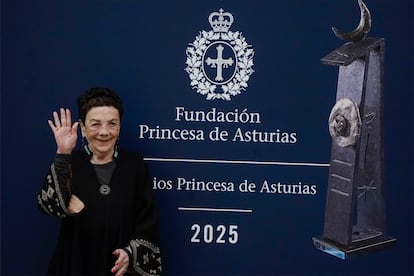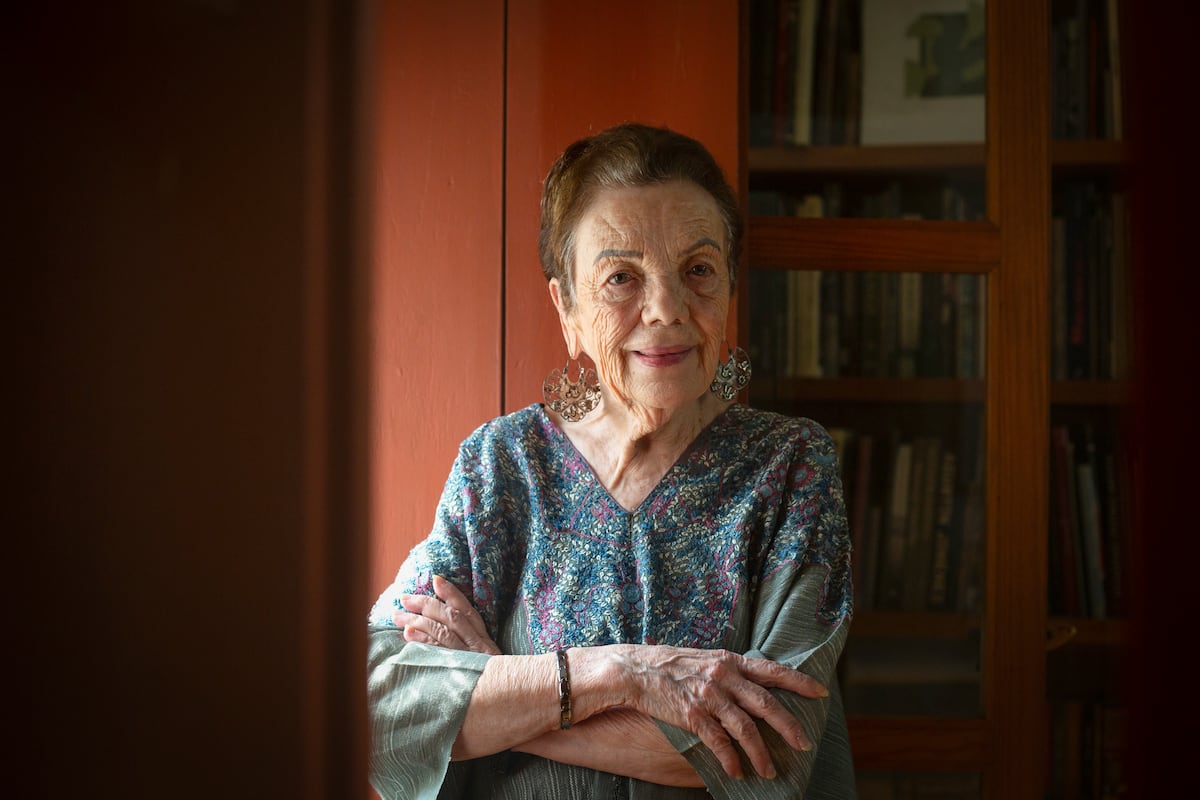The Mexican photographer Graciela Iturbide, 83, stated in a 2018 interview that “a photograph will never change the world.” This view is reflected in the artistic and anthropological gaze that Iturbide has directed at the forgotten villages of deep Mexico, riven by poverty, and on the faces of the Indigenous people she has dignified. A photograph may not change the world, but the poetic black-and-white images by Iturbide have managed to decolonize the condescending gaze normally aimed at these populations in order to portray life itself, without any qualifiers. It was a silent revolution in Mexican photography that will be honored with the 2025 Princess of Asturias Award for the Arts in Oviedo, Spain this Friday. “It is society, we, who have to change the world, not the photographs,” Iturbide asserts.
The artist, who has said that photography saved her from madness, has also led by example, traveling to places that have caught her attention to present an intimate and respectful portrait of their inhabitants. Her work focuses on documenting Indigenous culture and their relationship with nature. In the 1970s, she traveled to Sonora, in northern Mexico, to photograph the Seri people, and from that experience emerged one of her most memorable works, Those Who Live in the Sand. Iturbide gained the complicity of the inhabitants of those inhospitable regions and produced some of the most iconic images of her career, such as Self-Portrait as Seri, in which she appears with her face painted in the traditional style of the Seri women, and Angel Woman, taken while descending from a cave in 1979.
Iturbide wanted to be an anthropologist, but it was too ambitious an aspiration for a young woman born into a conservative family, whose life was governed by religious dictates. “My aunt had a small chapel in her house with the Blessed Sacrament exposed, and there were always archbishops, bishops, and people from Opus Dei around,” she recounted in May, after learning she had won the prestigious Princess of Asturias Award. She also wanted to be a writer, but wasn’t allowed to either. “I always went to a religious school, to the Sacred Heart. Being at that boarding school helped because they had a very good library of the Spanish Golden Age where you could read. Because they didn’t let you speak, it was like being a nun. My father never let me go to university to study literature,” she said. Neither a writer nor an anthropologist by trade, but one by passion, her anthropological gaze has portrayed a Mexico that, at the very least, had been in darkness. “I love all the ruins, all the history of Mexico. In a way, photography helps me discover the archaeological side of Mexico, the poetic side. The camera gives you so many possibilities,” she says.
That passion for Mexico led her in the 1980s to spend six years in Juchitán, a municipality in rural Oaxaca located on the Isthmus of Tehuantepec, where she portrayed the daily life of that indigenous community, a town known for its rich Zapotec traditions. Perhaps her most celebrated work, it was the one that catapulted her to the top of world photography. It was at the invitation of the artist Francisco Toledo, who was born in that town. “Toledo was a great artist and a very generous man. He gave me some prints to sell so I could travel to Juchitán,” Iturbide said. Toledo also recommended her, and the people of Juchitán welcomed her hospitably. Iturbide was amazed by the power of the women in that town, a matriarchal utopia. “I lived in the houses of the Juchitán women and in the end I was able to write a book called Juchitán de las Mujeres with Elena Poniatowska [1989]. I would go and stay for two weeks, because there was partying and drinking there, so I would say: ‘Okay, okay.’ I would accompany them, take my photos, come back, develop them, and see. And after six years of going back and forth, what Toledo told me, for which I am very grateful, was: ‘When you have the photos, you have to exhibit them at the Juchitán House of Culture, so that the women can see what you did.’ We did that exhibition, my first. It was very nice to give back to the people what I had done. Toledo was another of the key people in my life,” she recounted.
 Graciela Iturbide at the Reconquista Hotel in Oviedo, on October 19.Paco Paredes (EFE)
Graciela Iturbide at the Reconquista Hotel in Oviedo, on October 19.Paco Paredes (EFE)
The Mexican photographer Pablo Ortiz Monasterio worked with Iturbide as an editor on that project. They are very dear friends, and he says he admires her work and her approach to her photographic endeavors. “My own growth has come with Graciela,” he says. “She has those feminine qualities that we appreciate so much today: sweetness, motherhood, the ability to see death, and respect. She represents an attitude of rectitude and honesty with those she portrays, with what she portrays. Furthermore, she has been consistent, and it shows, because when you look at her photos, everything has dignity and a great deal of beauty. She is a global benchmark. I would say that today there is no other Mexican with a similar stature,” he affirms.
The Mexican photographer Elsa Medina, one of the country’s leading exponents of photojournalism, affirms that Iturbide has left a profound legacy in Mexican photography, with work that has influenced several generations of local photographers. “You can’t help but see her beautiful images, like those of birds, for example, and other terrifying ones, like the ones she took following people to a cemetery. It’s admirable that she continues working with analog photography; I think it’s worthy of continuing to do so. Her work is a great legacy she leaves behind for this country within the field of photography, with her name, but also on behalf of the women of Mexico.”
Iturbide says that it is precisely respect for others that has allowed her to do her work. “I want to capture people with the respect they deserve, not to photograph poverty for the sake of it. I’ve never been interested in that; I hate it. I like to connect with them and try to show their dignity. We have a lot to learn from them; they belong to our culture. However, photography is subjective; the images of the women I took from Juchitán are my own Juchitán. It’s not like when they come from outside to see ‘the exotic,’” she insists. Perhaps a photograph will never change the world, but Graciela Iturbide’s gaze has allowed us to see the life she captured in her poetic black-and-white photos in a more dignified way, without portraying it as exotic.
Sign up for our weekly newsletter to get more English-language news coverage from EL PAÍS USA Edition

